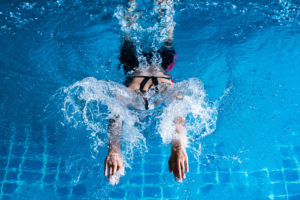
Become a Master of the 4 Strokes of Swimming
There are 4 strokes of swimming that every water lover should know, which will not only help you become a better swimmer, but will also help you master your favourite sport.
Let’s face it. You’re not going to become the next Michael Phelps overnight. However, these tips combined with hard work and practice will help you or your children become an expert in no time.
The Breaststroke
When doing the breaststroke, your body position is the most important element. Your body needs to stay flat the entire time, face down, with your arms and legs extended.
You want to make sure you are not dragging your body, and that your body sits high in the water. This will help give you that glide that the Olympic swimmers make look so easy. Think of the breaststroke like you are mimicking a frog: kick out your legs in wide motions and sweep your arms to the outside at the same time. Push off from the pool wall to help give you a good start.
The Backstroke
The backstroke is one of the least strenuous out of the 4 strokes of swimming because your head stays above the water and can help take some of the stress off of your back.
During the backstroke, keep your ears just above the water. Stay on your back and keep your body in a horizontal position, as straight as possible. Each time you take a stroke, your body will tilt toward the side of the arm you’re using. Move your arms like a windmill, fully extended, and perform flutter kicks with your legs.
We offer swim classes for people of all ages, from babies to adults. In fact, there are many benefits to adult swimming lessons besides learning the 4 strokes of swimming.
Freestyle
The freestyle stroke is not actually a specific stroke itself, but it actually refers to a category in swim competitions. In fact, the freestyle is often synonymous with the front crawl.
To do the front crawl, you are essentially flutter kicking your feet while alternating your strokes. Your arms complete circular motions in the direction you are going. Lie flat, with your face down in the water, and rotate your body side to side depending on what arm you are using.
The Butterfly
Doing the butterfly might look hard, but it’s all about moving forward and not kicking too much.
Start face down, with your arms pointing ahead of you, in the direction you’re going to go. Keep your body horizontal, your hips at the water’s surface. Then, in a sweeping motion, move your arms down below your chest and past your waist, extending them as you go. As they come back up, move them out of the water and to the side. Be sure not to splash the water too much.
While you are moving your arms, it’s time to move your legs. Think of yourself as a mermaid or merman, wiggling your body instead of kicking, your hips moving up and down. Push off from the wall to start.
Get Help From an Experienced, Professional Instructor
At British Swim School, we have a team of amazing staff on hand who are ready to provide their guidance to help you and your children learn the 4 strokes of swimming. From the breaststroke to the backstroke, it’s never too late to learn to swim the right way.
References
Baey, M. (n.d.) How do you swim freestyle or front crawl? My Active SG. Retrieved from https://www.myactivesg.com/sports/swimming/training-method/swimming-for-beginners/how-to-swim-front-crawl.
Gerber, S. (n.d.) Swimming basics: A beginner’s guide to the breaststroke. Breaking Muscle. Retrieved from https://breakingmuscle.com/fitness/swimming-basics-a-beginners-guide-to-the-breaststroke-0.
Harriman, D. (2017). Backstroke swimming techniques. Livestrong. Retrieved from https://www.livestrong.com/article/465882-backstroke-swimming-techniques/.
Luebbers, M. (2017). How to swim butterfly. ThoughtCo. Retrieved from https://www.thoughtco.com/how-to-swim-butterfly-3168543.





